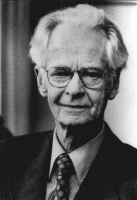










American psychologist B.F. Skinner is best known for developing the theory of behaviorism, and for his utopian novel Walden Two (1948).
Synopsis
Born in Pennsylvania in 1904, psychologist B.F. Skinner began working on ideas of human behavior after earning his doctorate from Harvard. Skinner's works include The Behavior of Organisms (1938) and a novel based on his theories Walden Two (1948). He explored behaviorism in relation to society in later books, including Beyond Freedom and Human Dignity (1971). Skinner died in Massachusetts in 1990.
Early Life
Burrhus Frederic Skinner was born on March 20, 1904, in the small town of Susquehanna, Pennsylvania, where he also grew up. His father was a lawyer and his mother stayed home to care for Skinner and his younger brother. At an early age, Skinner showed an interest in building different gadgets and contraptions.
As a student at Hamilton College, B.F. Skinner developed a passion for writing. He tried to become a professional writer after graduating in 1926, but with little success. Two years later, Skinner decided to pursue a new direction for his life. He enrolled at Harvard University to study psychology.
The Skinner Box
At Harvard, B.F. Skinner looked for a more objective and measured way to study behavior. He developed what he called an operant conditioning apparatus to do this, which became better known as the Skinner box. With this device, Skinner could study an animal interacting with its environment. He first studied rats in his experiments, seeing how the rodents discovered and used to a level in the box, which dispensed food at varying intervals.
Later, Skinner examined what behavior patterns developed in pigeons using the box. The pigeons pecked at a disc to gain access to food. From these studies, Skinner came to the conclusion that some form of reinforcement was crucial in learning new behaviors.
After finishing his doctorate degree and working as a researcher at Harvard, Skinner published the results of his operant conditioning experiments in The Behavior of Organisms (1938). His work drew comparisons to Ivan Pavlov, but Skinner's work involved learned responses to an environment rather than involuntary responses to stimuli.
Later Work
While teaching at University of Minnesota, Skinner tried to train pigeons to serve as guides for bombing runs during World War II. This project was cancelled, but he was able to teach them how to play ping pong. Skinner turned to a more domestic endeavor during the war. In 1943, he built a new type of crib for his second daughter Deborah at his wife's request. The couple already had a daughter named Julie. This clear box, called the "baby tender," was heated so that the baby didn't need blankets. There were no slats in the sides either, which also prevented possible injury.
In 1945, Skinner became the chair of the psychology department at Indiana University. But he left two years later to return to Harvard as a lecturer. Skinner received a professorship there in 1948 where he remained for the rest of his career. As his children grew, he became interested in education. Skinner developed a teaching machine to study learning in children. He later wrote The Technology of Teaching (1968).
Skinner presented a fictional interpretation of some of his views in the 1948 novel Walden Two, which proposed a type of utopian society. The people in the society were led to be good citizens through behavior modification—a system of rewards and punishments. The novel seemed to undermine Skinner's credibility with some of his academic colleagues. Others questioned his focus on scientific approaches to the exclusion of less tangible aspects of human existence.
In the late 1960s and early '70s, Skinner wrote several works applying his behavioral theories to society, including Beyond Freedom and Dignity (1971). He drew fire for seemingly implying that humans had no free will or individual consciousness. Noam Chomsky was among Skinner's critics. In 1974, Skinner tried to set the record straight regarding any misinterpretations of his work with About Behaviorism.
Final Years
In his later years, B.F. Skinner took to chronicling his life and research in a series of autobiographies. He also continued to be active in the field of behavioral psychology—field he helped popularize. In 1989, Skinner was diagnosed with leukemia. He succumbed to the disease the following year, dying at his home in Cambridge, Massachusetts, on August 18, 1990.
While many of his behavioral theories have fallen out of favor, Skinner's identification of the importance of reinforcement remains a critical discovery. He believed that positive reinforcement was a great tool for shaping behavior, an idea still valued in numerous settings including schools today. Skinner's beliefs are still being promoted by the B.F. Skinner Foundation, which is headed by his daughter, Julie S. Vargas.
National Medal of Science (1968)